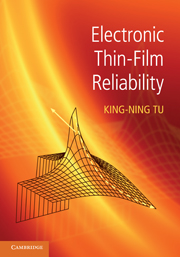Book contents
- Frontmatter
- Dedication
- Contents
- Preface
- 1 Thin-film applications to microelectronic technology
- 2 Thin-film deposition
- 3 Surface energies
- 4 Atomic diffusion in solids
- 5 Applications of the diffusion equation
- 6 Elastic stress and strain in thin films
- 7 Surface kinetic processes on thin films
- 8 Interdiffusion and reaction in thin films
- 9 Grain-boundary diffusion
- 10 Irreversible processes in interconnect and packaging technology
- 11 Electromigration in metals
- 12 Electromigration-induced failure in Al and Cu interconnects
- 13 Thermomigration
- 14 Stress migration in thin films
- 15 Reliability science and analysis
- Appendix A A brief review of thermodynamic functions
- Appendix B Defect concentration in solids
- Appendix C Derivation of Huntington's electron wind force
- Appendix D Elastic constants tables and conversions
- Appendix E Terrace size distribution in Si MBE
- Appendix F Interdiffusion coefficient
- Appendix G Tables of physical properties
- Index
- References
1 - Thin-film applications to microelectronic technology
Published online by Cambridge University Press: 05 July 2014
- Frontmatter
- Dedication
- Contents
- Preface
- 1 Thin-film applications to microelectronic technology
- 2 Thin-film deposition
- 3 Surface energies
- 4 Atomic diffusion in solids
- 5 Applications of the diffusion equation
- 6 Elastic stress and strain in thin films
- 7 Surface kinetic processes on thin films
- 8 Interdiffusion and reaction in thin films
- 9 Grain-boundary diffusion
- 10 Irreversible processes in interconnect and packaging technology
- 11 Electromigration in metals
- 12 Electromigration-induced failure in Al and Cu interconnects
- 13 Thermomigration
- 14 Stress migration in thin films
- 15 Reliability science and analysis
- Appendix A A brief review of thermodynamic functions
- Appendix B Defect concentration in solids
- Appendix C Derivation of Huntington's electron wind force
- Appendix D Elastic constants tables and conversions
- Appendix E Terrace size distribution in Si MBE
- Appendix F Interdiffusion coefficient
- Appendix G Tables of physical properties
- Index
- References
Summary
Introduction
Layered thin-film structures are used in microelectronic, opto-electronic, flat panel display, and electronic packaging technologies. A few examples are given below. Very large-scale integration (VLSI) of circuits on computer chips are made of multilayers of interconnects of thin metal films patterned into submicron-wide lines and vias. Semiconductor transistor devices rely on the growth of epitaxial thin layers on semiconductor substrates, such as the growth of a thin layer of p-type Si on a substrate of n+-type Si [1–3]. The gate of the transistor device is formed by the growth of a thin layer of oxide on the semiconductor. Solid-state lasers are made by sandwiching thin layers of light-emitting semiconductors between layers of a different semiconductor. In electronic and optical systems, the active device elements lie within the top few microns of the surface; this is the province of thin-film technology. Thin films bridge the gap between monolayer (or nanoscale structures) and bulk structures. They span thicknesses ranging from a few nanometers to a few microns. This book deals with the science of processing and reliability of thin films as they apply to electronic technology and devices [4]. To begin, this chapter describes the application of thin films to modern advanced technologies with examples.
- Type
- Chapter
- Information
- Electronic Thin-Film Reliability , pp. 1 - 13Publisher: Cambridge University PressPrint publication year: 2010



